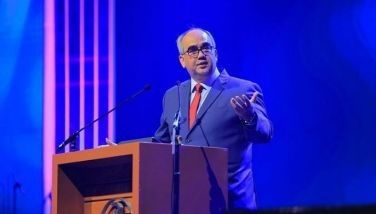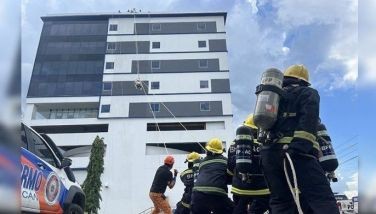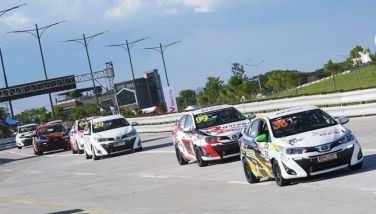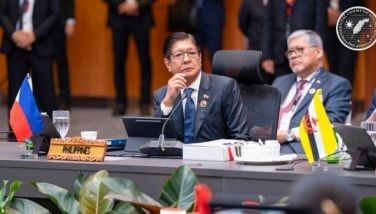What happens now?

The relief operations are far from over. As this column is being written, there are reports of far flung barangays still waiting for relief goods to come their way. There are problems in logistics still… not enough trucks… not enough ferries … not enough gasoline in the most devastated areas.
We will probably be in relief mode for the next two weeks or even a month or so. Yolanda just so totally devastated wide areas of human settlements to make it difficult to get back to normal. P-Noy is saying he will stay put in Eastern Visayas until he is satisfied that things are starting to get well.
Putting most of government’s attention on the relief operations at this time is understandable. But someone in government had better start thinking of what to do thereafter. Some thought must be given on what to do about resurrecting the heavily devastated cities like Tacloban. Refugees are streaming into Manila and heaven knows we have our problems too.
It is good to know that Economic Planning Secretary Arsi Balisacan is now busy trying to figure out the best approach towards rehabilitation. The National Economic and Development Authority (NEDA), which Arsi heads, is spearheading the development of a recovery and reconstruction plan to restore normalcy in regions hit by typhoon Yolanda and help get the affected local economies back on their feet.
Sec. Arsi is leading the effort to craft such a plan, focusing on immediate and near-term actions needed to rebuild facilities, restore social services and revive economic activities. The plan, which will be presented to the President in three weeks’ time, will be implemented immediately following relief operations in affected areas.
Albay Gov. Joey Salceda, an economist who was recently elected chairman of the United Nations’ Green Climate Fund, estimated the impact of Yolanda on the Philippine economy could be as much as P604 billion, or five percent of the country’s gross domestic product.
“In dollar terms ($14 billion), this is more than three times the reconstruction cost of Pepeng and Ondoy. This will have a major punch on the fourth quarter GDP this year but it will have its full impact lag into 2014. This overlaps with the negative impact or reconstruction demand from (typhoon) Pablo, the battle of Zamboanga and Bohol (earthquake) which total another P60 billion,†Salceda said.
Gov. Joey, who is probably one of very few local officials with proven experience in handling such natural disasters, said he based his estimates on data cited by Bloomberg senior analyst Jonathan Adams who used Kinetic Analysis Corp. in assessing Yolanda’s damage.
Salceda thinks the P23 billion that government is allocating for the reconstruction of damaged infrastructure is insufficient to replace the economic capacity lost to Yolanda. That would limit the country’s economic growth to five percent.
At the annual meeting of the Philippine Economics Society, Bank of the Philippine Islands (BPI) president Cezar Consing struck a more optimistic view. “Surely, from the standpoint of macroeconomic performance, the tragedy in Eastern Visayas is manageable. The region accounts for only two percent of GDP. With the budget deficit at only 2.3 percent of GDP, the government has the wherewithal to step up spending.â€
The banker continued: “In fact, while Secretary Purisima has indicated that the GDP growth rate in 2014 can be reduced by 1 percent as a result of the calamity, our economists in the bank think that 6.5 percent to seven percent growth in 2014 is still very achievable.
“Even Yolanda’s inflation impact should be muted. Eastern Visayas accounts for only 3.5 percent of sugarcane production, and the rice reportedly lost is less than a hundredth of the country’s total annual production, principally because most of the rice had already been harvested.â€
The other silver lining, the banker pointed out, is “ironically, rebuilding efforts should provide a GDP boost in 2014. If there is one theme underlying the haunting post-typhoon images of Tacloban, it is the severe lack of, or shortcomings in, public goods in all its forms -- power, water, roads, bridges, airports, hospitals, military transport vehicles.â€
BPI’s Consing explains: “As all of us intuitively understand, sustainable growth requires an ample supply of public goods. There are limits to privatization… But provide a strong base of public goods, and the private sector will follow the money to provide the ‘oomph’ that every healthy economy needs.
“Inclusive growth is probably even more dependent on public goods. The poor have less ability to pay as they go. A good baseline of public goods does more to improve the relative situation of the poorest amongst us than the richest amongst us. Indeed, the countries with the best public infrastructures tend to be the most economically inclusive.â€
Speaking of Tacloban, the banker remarked that “Tacloban is frightening because it could be any place in our beloved country. Tacloban is depressing because it reveals a chink in our armor, and rips away at our growing confidence that, as a nation, we are about to join the more developed countries in the region. Tacloban is infuriating because, by bringing to the fore the dearth of public infrastructure, it exemplifies the true cost of graft, corruption, and tax evasion.â€
But Consing said, “Tacloban need not be an absolute disaster, its handling need not be a national shame. Tacloban need not derail our growing confidence that our country’s economic prosperity is attainable in our lifetimes. But if we are to regain our mojo, we must step up.
“Government must do more to provide the public goods that will be supportive of sustainable and inclusive economic growth. As a people, we have to learn to accept, and in fact champion, rigorous, unflinching campaigns to curb tax evasion, graft and corruption, and administrative incompetence, for how else can we afford what we have to afford?â€
Thus, Sec. Arsi explains what his recovery task force is supposed to accomplish. For starters, the Yolanda recovery and reconstruction plan aims to speed up government operations to enhance delivery of services in the affected areas; find and develop resettlement sites; and restore public utilities and facilities using upgraded standards.
Sec. Arsi’s group will prepare a detailed master plan, indicating short-term and long-term actions. Immediate actions include assessment of damage to infrastructure and preparation of more resilient design standards for infrastructure projects.
The economic planning chief said new standards will be used in the rehabilitation and construction of critical infrastructure such as housing, roads and bridges, hospitals, provincial, city and municipal halls, seaports and airports, public markets, water supply and distribution systems, irrigation systems, power, telecommunications as well as other government offices and facilities.
“These actions must be completed in the shortest possible time, to restore people’s means of livelihood and revive economic and business activities,†Balisacan said. Whether this administration, based on its record so far, has what it takes to move fast in rolling out needed infrastructure under the plan requires a big leap of faith.
Gov. Joey Salceda warned about the national embarrassment of becoming another Haiti. “Since the Haitian earthquake in Jan. 12, 2010, almost $6 billion has been disbursed in official aid in a country with a population of just under 10 million. On top of that, an estimated $3 billion has been donated to NGOs in private contributions. The United States pledged over $3 billion for relief and reconstruction.
“Yet almost four years after the quake, there is little to show for this: even the capital, Port-au-Prince, still does not have decent roads, running water, or reliable electricity. After almost four years, an estimated 200,000 to 400,000 Haitians still live in the tents provided by relief agencies soon after the quake.â€
Indeed, Yolanda’s impact effectively forces us to start the redevelopment of Tacloban and other similarly affected cities from scratch. Jun Palafox texted me to say that he is proposing the replanning, remaking and rebuilding of Tacloban City taking lessons from mistakes and applying the best practices in the world.
Palafox recommends a review of our planning, building and zoning codes which do not address wind speed of super typhoons, other hazards like storm surge, among others. He suggested that planners from the Philippine Institute of Environmental Planners and other architects and engineers to volunteer their services to help replan all disaster areas.
Palafox also suggested using Tacloban as the venue for a Center for Climate Change to drive home the need to address climate change risks.
There is indeed a long road to rehabilitation. The last thing we want to happen is to become another Haiti. I don’t see the work being done within the remaining years of P-Noy in office. But I am hoping that he would have set the foundations for getting the proper work done within his term.
The question is, Is P-Noy up to it? Amanpour is right. Yolanda will define his presidency.
Boo Chanco’s e-mail address is bchanco@gmail.com. Follow him on Twitter @boochanco
- Latest
- Trending






























